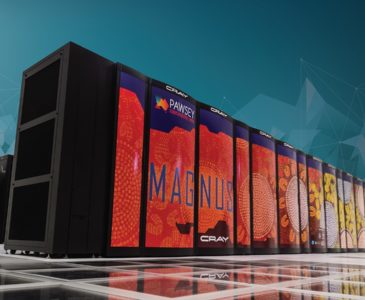The Pawsey Supercomputing Centre in Perth, Western Australia, has had a busy year. Pawsey typically spends much of its time looking to the stars, working with a variety of observatories and astronomers – but when COVID-19 hit, Earth demanded more of its attention. Even during a hectic time, Pawsey managed to net four nominations in the HPCwire Readers’ Choice Awards, including one for its work on COVID-19. Now, Pawsey is receiving a major upgrade to its supercomputing capabilities: a $33.8 million system provided by HPE that will stand as the most powerful system in Australia.

The new system – as-yet unnamed – will use the HPE Cray EX architecture, next-generation AMD Epyc CPUs and AMD Instinct GPUs and the Cray ClusterStor E1000 data storage system. It will be supplanting Pawsey’s Galaxy and Magnus systems, which were commissioned in 2013 and 2014, respectively, and are rated at 227 and 1,486 peak teraflops. HPE and Pawsey say that the new system will offer roughly 30 times the performance of Galaxy and Magnus combined, peaking at around 50 petaflops.
“AMD is excited to help accelerate groundbreaking scientific research with our high-performance processors in the next-generation HPE and Pawsey supercomputer,” said Forrest Norrod, senior vice president and general manager, AMD Data Center and Embedded Systems Group. “Significant new discoveries will be made at the Centre for years to come, enabled by Pawsey’s almost 50 petaflops of supercomputing capacity.”
Pawsey also claims the new system will offer ten times the energy efficiency of its predecessors. It will be cooled by a groundwater cooling system developed by Australia’s Commonwealth Scientific and Industrial Research Organisation (CSIRO) specifically for Pawsey, which itself will leverage a 118 kW photovoltaic solar array.
The new supercomputer, HPE says, will be used for accelerating research across fields like astronomy, plant pathology and drug discovery.
“Scientific breakthroughs made by world leading research centers, such as Pawsey Supercomputer Centre, inspire us to continue empowering the community with powerful supercomputing solutions that combat the broadest range of challenges,” said Nick Gorga, general manager for HPC and AI, APAC-India at HPE. “We look forward to collaborating with AMD to build Pawsey the most powerful system for the region and boost Australia’s research capabilities to advance missions from understanding human viruses to discovering new galaxies.”
The funds for the system are coming from the Pawsey Capital Refresh Program, which will have roughly $15.5 million remaining after paying for the new system. Pawsey expects that the first phase of the system, which will offer a 45 percent increase in compute power over its predecessors, will be delivered by Q3 2021; the second phase, it says, will be commissioned by Q2 2022.
“Supercomputers like those at Pawsey are increasingly crucial to our ability to conduct world-class, high-impact research. The upgrades we’re announcing are a critical move in strengthening Australia’s position in the global research environment and playing a part in major global research projects, from helping in the fight against COVID-19 to working with the precursor telescopes to the Square Kilometre Array,” said Mark Stickells, executive director at Pawsey. “The new supercomputer built by HPE will not only deliver next generation compute power to meet these growing requirements, it will enable entirely new research projects with global reach and impact.”
Pawsey is also preparing to transition its existing users over to the new system through a variety of initiatives. The first of these is the Pawsey Supercomputing Centre for Extreme scale Readiness (PACER) program, which aims to boost researchers’ optimization and workflow readiness by running a grand challenge problem at previously unavailable scales. Applications for PACER will open next month.
Just a couple months ago, Pawsey welcomed a new GPU cluster (called “Garrawarla”), a 78-node, 546-peak teraflops system with hardware from HPE, Intel and Nvidia. Garrawarla is intended to serve the Square Kilometre Array (SKA), which, when it becomes operational in the coming years, will be the world’s largest radio telescope.



























































